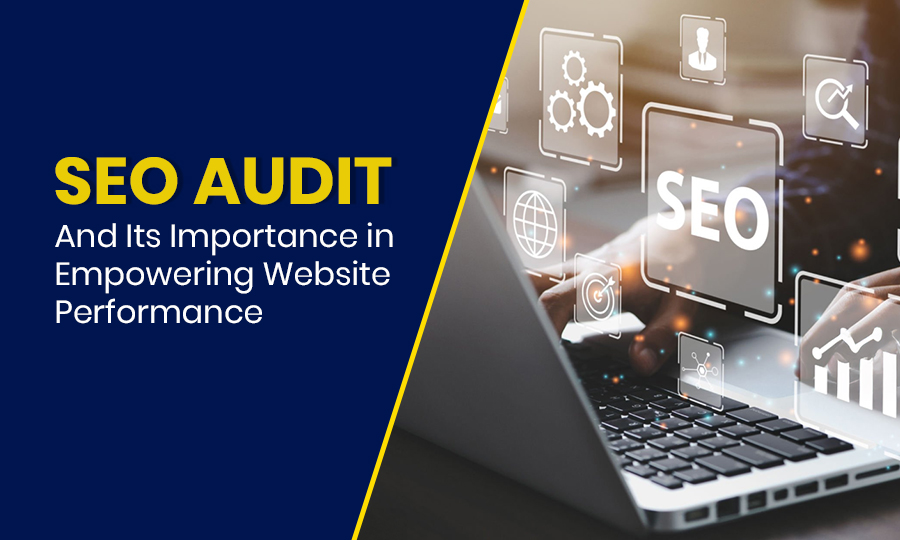
As the global market scenario has evolved by means of socio-economic and socio-cultural factors, companies tend to adopt advanced strategies and tools to keep them relevant and updated. However, due to the emergence of digital platforms and their cohesive role in shaping modern businesses, companies aim to ensure a strong digital presence through applications and websites and provide smart customer service. SEO programmes and SEO audits, in this regard, have been valuable for companies to improve their search ranking and website performance.
Research shows 68% of trackable website traffic comes from organic and paid search. In this regard must focus on strong content, design, and higher search ranking to improve market footprint and experience better opportunities.
Here, you will have a detailed discussion on SEO audits and why it is important for your website.
What is an SEO Audit?
An SEO audit refers to the evaluation of a website’s performance in search engine rankings in a comprehensive approach.
Well, you may find it a very linear definition, so let us explain what it is and what it does.
An SEO audit identifies key areas where a website can boost its organic traffic and visibility by analysing several aspects, such as on-page content, technical elements and off-page factors. Precisely, it is a health-checking programme for a website’s SEO, which essentially reveals potential challenges and opportunities regarding site optimisation.
Here are some key facts you must know about it.
- An SEO Audit pinpoints where a website faces issues and where it excels, based on search engine results.
- It uncovers off-page, on-page and technical issues, hindering the efficiency of a website’s ability to rank higher in search engines.
- It improves the overall user experience by addressing issues that are difficult to navigate.
- An SEO audit provides valuable insights, which can be used efficiently to improve and refine the SEO strategy of a website, leading to maximum return on investment (ROI).
Why is an SEO Audit Important for Your Website?
As Peter Thaleikis said, “I tend to describe SEO as a creative number game: You need basic skills such as writing, technical analysis, building relationships, and logical thinking. But once you’ve ticked these boxes off, it becomes a numbers game.”
It means a brand’s SEO programmes need stronger support to empower its website’s visibility, ranking and performance. In this regard, SEO audits not only address technical issues or identify on-page challenges, but also help to improve content strategy on a significant scale.
Here you can find some key significance of conducting an SEO audit.
1. Reveals Technical Issues To Address
Do you know that the top Google results include 27.6% of all clicks, while 0.63% of users move beyond the first page?
The data shows how essential high rankings are for organic traffic. In this regard, an SEO audit helps identify issues regarding SEO programmes to improve a website’s performance. Here are some details for a better understanding!
- Through an SEO audit tool and strategy, you can avoid challenges regarding redirections and Error 404. In this case, managing image size is advantageous, as it improves SEO and page load time and users do not have to wait for long.
- SEO audits develop several subfolders to keep a clear site structure and make the URLs short and informative. A well-optimised website makes it comfortable for both search engines and users to navigate a website.
- These audits can also identify coding issues such as duplicate CSS, JavaScript or HTML code, which reduces download speeds.
2. Identifies Your Website’s On-Page Problems
So, On-page SEO optimises the content of a website and an audit tool improves its rankings. However, it also makes things easier to comprehend what a website is about and helps index website content.
- An SEO audit improves meta descriptions and titles. Through this, you can keep the title between 35-70 characters and descriptions under 155 characters, including keywords and a CTA (call to action).
- Internal linking, driven through SEO audits, helps search engines understand website structures and identify new pages, ensuring a better navigation of websites.
- Audits identify broken and spammy links, affecting content structure, quality and ranking, and replace or remove them, ensuring on-page optimisation and higher organic traffic.
3. Identifies Competitors
An effective audit not only ensures a site’s authority through relevant actions and strategies, but also helps you know your competitor and their SEO strategies.
Here are some facts regarding the identification of competitors’ strategies through SEO audits!
- Having a clear overview of competitors is important to create better strategies to stay ahead.
- Through SEO audits, you can understand the digital marketing strategies of competitors and can adopt strategies and tools to reach potential customers more effectively.
- An improved SEO performance can be advantageous in creating exclusive opportunities and improving ROI.
4. Identifies Your Backlinks
Backlinks are one of the most significant components of Google’s algorithm. Here’s study-based evidence for you!
- Research shows the first-ranked search result contains 3.8x more backlinks than the 2nd-10th search results.
It means a website with reputable links improves search rankings, while the backlink audit ensures a better user experience and engagement.
Remember, an effective website audit must answer these queries about backlinks.
- How many backlinks should a website have to ensure a higher search ranking?
- Is the quality of backlinks reliable and useful?
- Where do those backlinks point to?
- From where are the competitors’ backlinks generating?
5. Helps You Build a Better Content Strategy
Content strategy stands for a comprehensive plan to create, distribute, and manage content to achieve key business goals. It encompasses several steps and stages, ensuring content reaches and engages.
- An audit can improve the quality of your marketing content (blogs, articles, and others), which can attract backlinks and improve the overall authority of your website.
- Site owners can enhance the number of website visitors by improving content structure and language.
- An audit is also valuable to help convert leads more effectively and empower the business position in the market.
How to Perform a Local and Non-Local SEO Audit for Your Website
You might find performing an SEO audit a daunting job due to its complex nature and strategic requirements.
Well, in that case, we have categorized some steps based on which you can experience a better performance of your website and opportunities.
Here are the 8 steps you can follow to perform an SEO audit and experience premium opportunities!
1. Content Quality Review
Before any details, you must know one thing.
No amount of technical optimization and effective backlinks is sufficient to rank your content if it is not engaging and not up to the mark.
So, in this step, you need to examine the pages and posts and assess their quality. Here are the questions that you need to focus on.
- Is all the content available on your website unique?
- Are you sure about their readability?
- What about the format?
- Is the content up-to-date?
- Does it answer queries effectively?
Now, check this statistic.
- Research shows 87% of consumers prioritize product content before purchasing from online platforms.
It means you cannot be casual about the product content you share on your website page. In this regard, you need to identify common errors, such as broken internal links and misspelled words, which can demotivate users on a significant scale. For this, you can follow these strategies.
- First, check Google Search Console. You need to filter the performance report based on specific pages you’re concerned about. If you find no clicks or impressions, it means the page has not ranked.
- Index the coverage report. The report shows the indexed pages, as well as the errors, indicating potential issues.
- Identify the keywords, using UberSuggests, Ahrefs, SEMrush and Google Keyword Planner, based on which your content may rank, and use them appropriately.
Apart from this, you also need to identify duplicate content, and in this regard, you can access your website through these URLs.
- https://yourdomain.com
- http://yourdomain.com
- https://www.yourdomain.com
- http://www.yourdomain.com
You are suggested to use the HTTPS version, as it encrypts data between browsers and the server, improving user trust and security, as well as boosting brand ranking.
2. User Experience and Web Accessibility
The concept of “core web vitals“ is widely followed by Google to measure how fast pages load and how visitors can interact with them. Before deciding on its role in deciding user experience and web accessibility, check the three key components and their functions.
- Largest Contentful Paint (LCP): It measures the perceived speed of load by users and provides information on how long the main content of website pages takes to load. Ideally, it should load within 2.5 seconds.
- Interaction to Next Paint (INP): INP measures how responsive the user interface is, which means how fast websites respond to users. You must aim to ensure the INP score <200 milliseconds.
- Cumulative Layout Shift (CLS): It measures the visual responsibility, such as shifts in the page layout. A score of less than 0.1 is ideal. A CLS score <0.1 seconds is ideal in nature.
Based on the core web vitals, a smooth user experience is ensured, as well as organic traffic is increased, as websites and content become easily accessible to different types of users. In this step, the search results tend to improve, focusing on navigation, menus, image alt text, and other elements, while the site architecture is made easier to follow.
Now, here are our suggestions to address several issues!
- To address LCP issues, you must improve the server response times and eliminate several render-blocking sources (e.g., JavaScript files and CSS).
- To minimize INP challenges, you can optimize event handlers and eliminate third-party scripts. In this regard, you can use Google PageSpeed Insights or browser developer tools.
- Specify height and width attributes for videos and images for dynamic content like advertisements to ensure a better CLS score.
3. Titles, Meta Titles, Headers and Meta Descriptions: On-Page SEO
In this step of SEO, the site audit covers numerous on-page elements and SEO factors, including titles, headers, meta titles, and meta descriptions.
- Title: The title of every SEO page should reflect the subject matter uniquely, as it sets readers’ expectations for the page content.
- Meta Titles and Descriptions: Readers initially check meta titles and descriptions that appear on search engine results. So, they are written with care to encourage readers to click through the site.
- Headers: Each page is entitled to a single main header (H1). Following H1, several subsections (H2 for 2nd-level subheadings and H3 for 3rd-level subheadings) are created, based on a logical hierarchy.
Effective title tags and meta descriptions are deployed to attract readers from different backgrounds and brands try to enhance their engagement for long-term success.
Here are the steps and strategies you can follow to improve audit results.
- Make sure your content has a title tag under 55 characters, including keyword(s).
- Provide unique meta descriptions, under 120 characters.
- Use an H1 tag, following the key topic and using relevant keywords.
- A logical structure, including H2s, H3s, H4s and others, if required.
- Descriptive, clean and keyword-rich URL structures.
- Use descriptive alt text for content images for better understanding.
If you manage a large website, examining each page (including the landing page) would be time-consuming in nature. In this regard, you can take technical help from SEMrush’s On-Page SEO Checker.
4. Technical SEO audit
You need two key tools for a technical site audit.
- Google Search Console
- A crawl-based tool, such as Site Audit by SEMrush.
By using the Site Audit tool, we scan websites and procure data regarding every page.
- To set up the first crawl, we create a project.
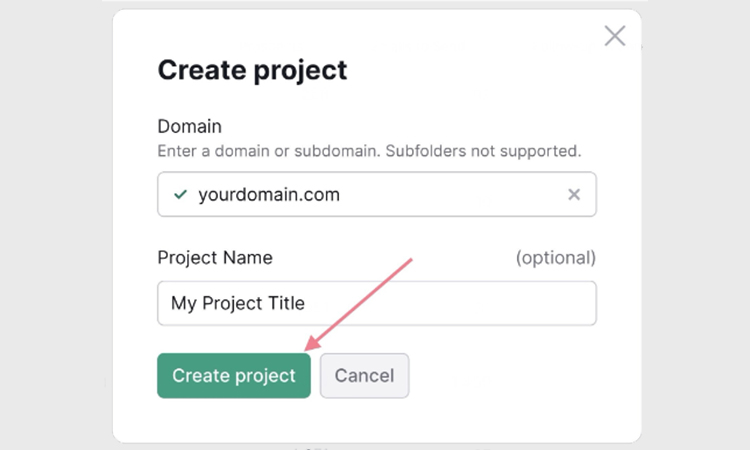
- Next, head to the site audit tool and select My Site.
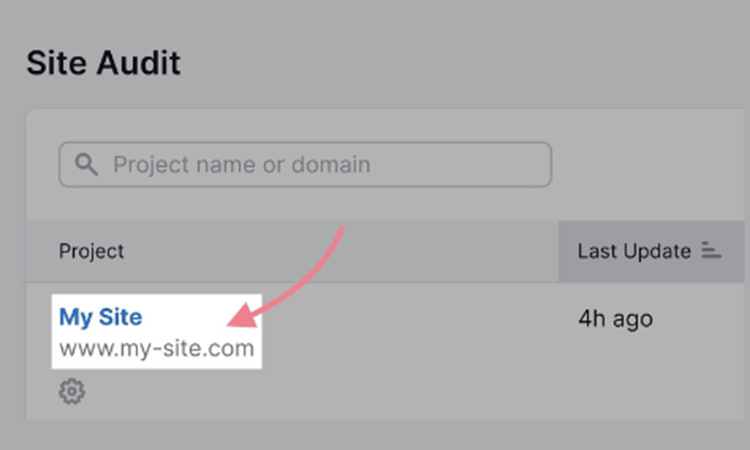
- The window, Site Audit Settings, pops up. Here, we configure the fundamental factors of the first crawl.
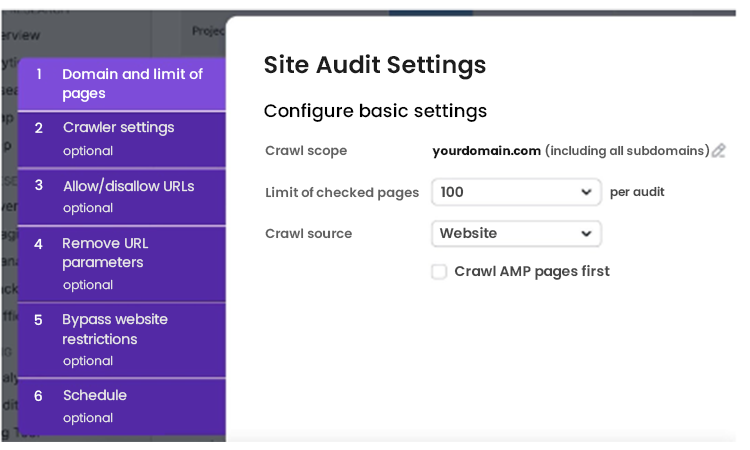
- Finally, click on Start Site Audit.
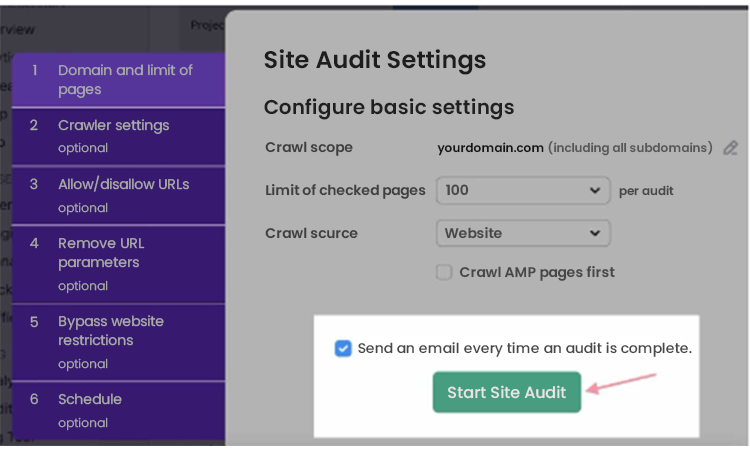
Based on technical SEO checking, we examine the structural elements that can influence how easily search engines can index and crawl a website. It includes three key features.
- Various “error response codes”, such as server issues (503 error) and missing pages (404 error).
- Improper or missing use of relevant structured data for important pages and admin pages.
- General site structure, such as “orphan pages” with zero internal links.
However, fewer pages with broken links might not affect the entire site, but a site with several error codes and an inappropriate internal link structure might affect the Google search and ranking, leading to ranking issues, especially a Google penalty.
5. Performance and Mobile Friendliness
- Research shows that, In the last quarter of 2024, 62.54% of global web traffic is generated through mobile devices.
In this regard, we prioritize the site speed, as search engines and readers prefer fast sites.
- Google prefers pages with less than 3 seconds loading time. Comparatively slower sites experience a Google penalty, lower user engagement and issues regarding conversions.
- Using a free SEO audit tool, as well as exclusive paid services, we focus on identifying large files, ineffective coding and other SEO factors that may impact loading speed.
- We focus on buttons, font size and links with enough readability, and ensure that important pages are easy to navigate.
The easiest method to check the mobile-friendliness of a site is to use the “Mobile Friendliness Test Tool“. All you need to do, enter the website URL and the tool will provide results on mobile usability standards.
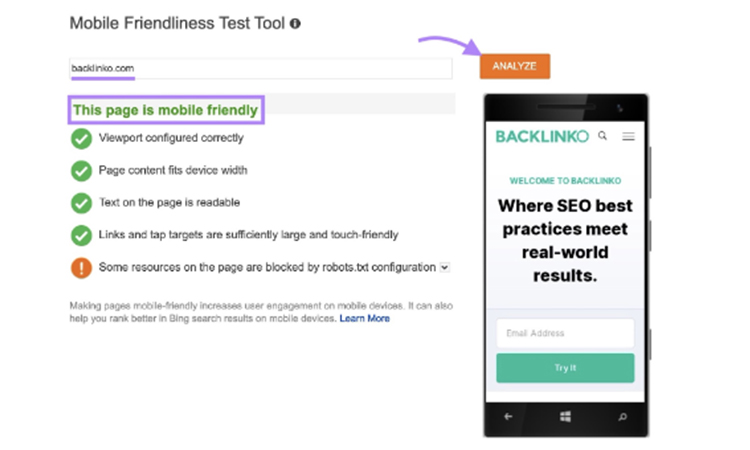
If the result is negative, focus on improving these aspects for better search engine results.
- First, ensure the content is easily readable without zooming.
- Make sure that your site can scale accurately, as per devices of different sizes.
- Ensure all the interactive elements work effectively on mobile devices.
- Optimize your website for less loading time.
6. Analyse Your Organic Traffic
The organic traffic shows the number of visits to your site, based on organic search results.
Remember, this is a central metric of your brand SEO.
In this regard, you need to check the Google Search Console search results report to check traffic and total clicks over time. You should note sharp spikes or drops from the report.

Now, if you find significant drops, identify the key reasons behind them. FYI, sustained or sharp traffic drops are mostly caused due to two things.
- Manual actions (Penalties empowered by Google, if you violate the guidelines)
- Algorithm updates.
As Google updates search algorithms regularly, you will mostly find minor updates, but in some cases, major updates can impact search results and rankings.
No worries, as you can find the changes in the Search Central Blog.
However, if you find some unexplained traffic drops, you can check for manual actions.
- Visit the “Manual Actions” report in Google Search Console to know why your site faced the penalty.
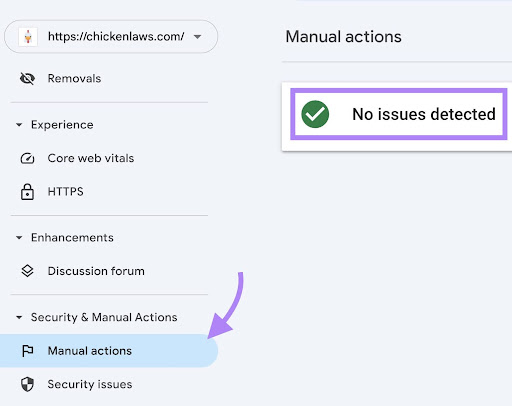
7. Identify Opportunities based on Missing Backlinks
You must look for reliable and effective backlink opportunities, which have already been capitalised on by your competitors, but you have yet to do so.
Remember, backlinks are essential to improve your ranking and user engagement to stay ahead of competitors.
You can conduct backlink gap analysis, considering Ahrefs. Here’s the process you can follow!
- First, make a copy of the “backlink gap analysis template”, followed by searching your website in Ahrefs Site Explorer and navigating to organic competitors.
- Now, check the domain rating (DR) to identify your competitors that are superior to you and keep the list available for further practices.
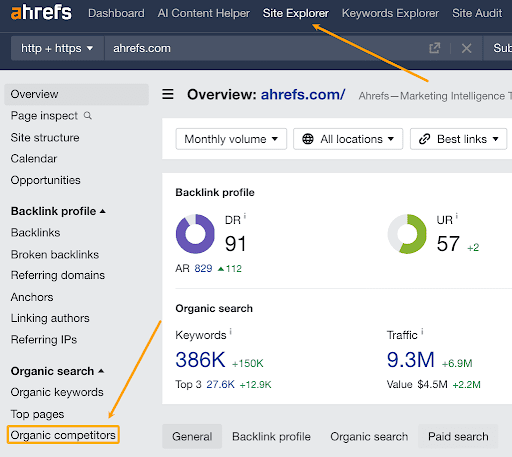
- Open the competitive analysis tool of Ahrefs and make sure you keep it to “referring domains”.
- Add your website where you find “the target doesn’t rank for” and add the list of competitors.
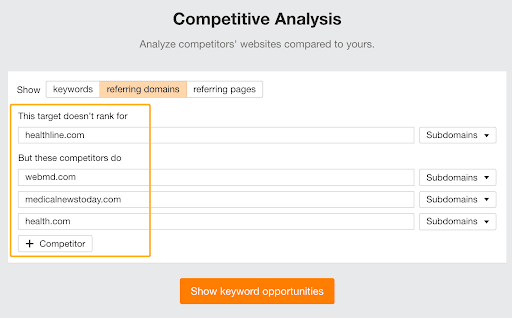
- Click on “show link opportunities” to check the list of websites based on which your competitors have ranked.
- Now, you need to look at the domains that are linked to all competitors, and if a site links to your competitors but not you, it’d be beneficial for you to be linked with it.
- You must analyze the individual relevance of domains to avoid irrelevant links, based on your brand requirements. You must start assessing the first domain in the list.
- Add relevant domains to the Link Gap Analysis Template, developed earlier.
- Repeat the processes to identify the exact referring pages linking to your brand competitors.
8. Check Your Presence in SERP Features
The SERP features are exclusive formats for search results that appear on the search results page. These mostly include:
- A concise answer, based on the featured snippet displayed near the top of the search results.
- PPA (People Also Ask) box shows relevant questions and answers.
- Local pack, a map with a local business listing, and an image pack, a group of images, appear in the search results.
- AI overview.
To check how often you appear in different SERP features, you can use the Position Tracking tool of SEMrush.
- First, you need to set up a project for your domain and let the tool collect data on your rankings.
- Next, click on Overview. Here, you can find SERP features as per the target keywords.
- For AI overviews, you solely need to follow the search guidelines of Google.
- For the other SERP features, the techniques for optimization change as per the SERP feature you target. For example, if you want to capture People Also Ask placements, you must identify common questions Google shows in the PAA box. You can do this by searching for the target keywords and focusing on questions that appear in the PAA section.
5 Key Challenges Regarding SEO Audit
An SEO audit stands for an opportunity to improve the quality and performance of a website. In this regard, several SEO factors are taken into account to improve the SEO score on a significant scale.
But the entire process is not linear, as it comes across several challenges affecting spontaneity and outcomes.
Here we’re going to talk about 5 key challenges that affect SEO audits.
1. Targeting the wrong keywords
Keywords are a key component of SEO, as targeting keywords assists website pages in appearing in search results. In that case, the issues regarding wrong keywords have been a key threat to companies to incorporate better SEO strategies through audits.
Issues regarding wrong keywords affect SEO audits in two ways.
- In several cases, SMEs and MNCs target short-tail keywords, leading to very little return. Apart from that, short-tail keywords are extremely competitive, which makes websites and content tough to rank on search engines.
- Secondly, some businesses undertake irrelevant keywords, as they solely focus on search volumes. But how does it go wrong? Let us explain. SMEs, in most cases, tend to choose keywords with higher search volume, even though they are not related to the brand name or brand services. It hampers brand recognition and affects stakeholder engagement due to the lack of leads.
2. Slow-loading Pages
Before any details, check these two statistics.
- Research shows a one-second delay in page loading leads to an 11% and 16% decrease in page views and customer satisfaction, respectively, and a 7% loss in conversions.
- A study by LiquidWeb suggests that 67% of companies experienced a loss of revenue due to poor website performance, driven by poor choice of primary keywords and delays in loading.
From these two studies, it can be observed that time-consuming websites and pages demotivate users and customers on a significant scale, which further affects several commercial aspects.
Slow loading times affect page-customer interaction, as they do not want to wait for long when they can find any of your competitors.
If your website takes a longer time to respond, it will eventually affect your SEO programmes and market-based practices, creating long-term issues for companies.
3. Changing Algorithm
Search engines, especially Google, update their ranking algorithms, which can range from some minor changes to core updates, substantially influencing the search results. Research shows, in 2023, Google conducted more than 700,000 experiments, leading to more than 4,000 improvements.
And here are two of the key reasons behind the changing algorithms.
The updates aim to deliver more relevant and accurate results for users’ queries by filtering how content is indexed and evaluated for long-term practices.
Algorithms are frequently updated to identify websites using manipulative tactics or sharing unoriginal content.
However, the changing algorithm is a key issue in SEO audits. Here are some key reasons and outcomes!
- Google and other search engines update their algorithms frequently, and it becomes difficult to stay updated about the latest trends and best practices. This is a key challenge for SEO audits, affecting brand recognition and digital ranking.
- A key drawback of frequently changing algorithms is issues regarding website traffic and visibility. The sudden impact on brand ranking and visibility leads to ROI issues, affecting long-term and mid-term goals of companies.
- In the case of SMEs, the lack of agility and flexibility is a key threat to SEO audits. The lack of audit tools, rich snippets, and backlink data affects their adaptability to deal with the changing market environment and algorithms.
4. Non-optimised Pages for Search
First, we will talk about a widely spread misconception.
A large number of companies believe that creating pages and targeting the right keywords are enough to rank in search engine results.
Sadly, NO. Using target keywords is not enough to rank in the search pages, as you also need to deliver an exceptional user experience, which is unique, accessible and helpful for users from different backgrounds.
Here are some key challenges that emerge due to non-optimised pages.
- Non-optimised website pages foster adverse user experience, lowering search engine rankings and increasing bounce rates, driven by slow loading time.
- Slow mobile load times and non-responsive page designs negatively impact user experience and post ranking on mobile-first websites.
- Non-optimized pages are often blocked by the XML sitemap or robots.txt issues, which restrict website content from being found easily and ranking on the first page.
- Duplicate content and broken links affect user experience on a significant scale, as well as penalize brands. It also leads to keyword cannibalisation, where various pages try to use the same keyword.
- An inadequate or missing title tag and meta description affect the relevance of content in search results and click-through rates.
5. AI-generated Content
The incorporation of AI in SEO audit programs may sound like a game-changing factor, but the challenges regarding AI-generated content
- Research shows 51% of marketers use AI-based tools to optimize content, from search engine optimization to email campaigns.
Although this number is emerging due to technologies like Bing AI and ChatGPT, two key challenges can be observed widely.
- The lack of originality
- Hallucinations
Does it sound confusing? Let us explain.
- AI produces content following the existing information only, so if you expect something extraordinary or exclusive, you might regret it. Due to the limited services, the lack of originality and exclusivity (based on certain products and services) affects brand engagement and market opportunities.
- AI programmes hallucinate, and it is dangerous. It means they are able to make up unauthorized information and develop content through it. So in that case, if you are not well aware of the topic or verifying the AI-based output, you would end up sharing false information and questionable content, affecting the organisational reputation.
5 Tips to Perform an SEO Audit Effectively
As you came across the challenges during SEO audits, you might have some forehead folds now, as the challenges are real and impactful.
Don’t worry, here are our tips to combat the issues and improve business resilience.
1. Use AI as a Supplemental Tool
As you found in the previous section, the overdependency on AI can be a threat to content originality, which further affects brand engagement and reputation. So, here are our suggestions to avoid the challenge.
- You can use AI as a key supplemental tool to overcome the challenges regarding the rapidly changing search engine algorithms and unoriginal content. It can be a valuable tool to conduct comprehensive research before developing and sharing content through digital platforms.
- By using AI as a supporting tool, you can improve your content creation process and bring efficiency. You can certainly experience real-time results and professional opportunities based on unique and authentic content.
2. Optimize Your Business Pages for Users
Optimising business pages is important in creating better opportunities and SEO, and in this regard, user-centric approaches can be advantageous.
Here are our tips to optimize your service pages and rank higher on Google searches.
- First, you must consider some expert input on the accuracy, usefulness, and quality of content to ensure your ranking on search engine results pages (SERPs).
- You can also use relevant tags, such as H2s, H3s, and H4s, to break down your content into different sections.
- Add several visual elements, such as videos and pictures, to assist users in understanding content and influence their decisions.
- You can use numbered and bulleted lists to improve readability and collaborate with developers and designers to enhance website accessibility and usability.
3. Carving Out Time to Deal With Algorithm Changes
The drastic changes in search engine algorithms can be a threat during SEO audits, but don’t worry, as we have some advanced tips for you.
- Based on your schedule, you should carve out time to verify and check changes in search engine algorithms.
- You can also join email lists or find trusted SEO blogs and podcasts to stay updated regarding changes, fostering brand opportunities on a significant scale.
- You need to implement A/B testing for various SEO strategies, including dealing with algorithm changes, while understanding their impact. Keep refining your approach in order to experience the best results.
- We highly recommend ensuring a mobile-friendly, fast, and intuitive user experience for customers and optimizing core aspects of your website, such as Cumulative Layout Shift (CLS), First Input Delay (FID), and Largest Contentful Paint (LCP).
Note: In case of relevant tools, you can adopt Google Search Console and Google Analytics to track changes in algorithms and track key metrics like ranking, organic traffic, and crawl errors.
4. Speed Up Your Website
As we mentioned before, slow website loading time can easily demotivate customers, so you need to keep your web vitals up-to-date and responsive to meet user demands.
- You need to select appropriate formats, such as PNG for graphics or images and JPEG for photos. To bring transparency, we suggest you use tools like JPEGmini and TinyPNG.
- You must ensure the images used in your content (blogs or articles) are sized properly for their display and avoid additional time consumption for large-sized files.
- If applicable, you can use a caching plugin to improve website performance. For example, WordPress users may incorporate WP Rocket as a plugin to optimize key aspects of websites and implement caching.
- Use Google PageSpeed Insights to note the current loading time of your website, based on which you find Google’s suggestions on fixing to improve.
However, here are some additional suggestions for you.
- Enable browser caching
- Minifying coding
- Hosting brand videos on third-party websites.
Since core web vitals are widely used by Google in the ranking system, it is important for brands to fix their page speed. Once you achieve a faster website, you can fuel your site to rank higher in search engine results, along with converting and capturing more traffic.
5. Target Relevant Long-tail Keywords
Long-tail keywords mostly consist of three or more words. You must be aware of relevant keywords, based on your brand services or products, to rank higher and attract customers from different socio-economic and cultural strata.
Here are our suggestions to target relevant and long-tail keywords to ensure better audit outcomes.
- First, conduct thorough keyword research and use tools like Moz Keyword Explorer and Google Keyword Planner to identify the right keywords for your brand. For example, if you run a brownies brand in LA, instead of targeting small keywords like “brownies,” your target keyword can be “small-batch brownies in LA“.
- You need to analyze top-ranking pages for the chosen-tail keywords to know about content already performing well and identify different areas for improvement.
- You must be aware of users’ search intent, such as navigational, informational, commercial, or transactional searches, so that you can focus on keywords.
Targeting long-tail keywords can empower your brand position and market reputation to reach a larger number of people and make them interested in your offers.
5 Best Audit Tools You Can Use for Your Website
SEO audit tools aim to empower the audit process with an advanced approach, which further creates opportunities for websites to perform according to their market objectives.
Here, you can find the 5 best audit tools that you can use for your website.
1. SEOptimer
| SEOptimer Pros | SEOptimer Cons | Pricing |
| Reasonable prices and rich in advanced features.More than 60 independent tools regarding auditing, research, and generationWhite-label reporting. | Key features (e.g., robust keyword tracking) are absent in the lowest tier.Crawl limits can be an issue while managing larger or multiple websites. | DIY SEO ($29/month)White Label ($39/month)White Label and Embedding ($59/month) |
Key Benefits
- SEOptimer is a quick audit tool, providing helpful metrics, such as on-page SEO, user-friendliness and social media viability.
- On the White Label tier, you can download reports in 15 languages, while with API access, it provides inclusive tools to solo consultants and small agencies, which they can deploy own clients.
- SEOptimer integrates with several tools, such as Google Analytics, while its API empowers lead generation and integrates SEO auditing into other applications. The automated SEO reporting service sends direct reports to users’ inboxes.
2. Morningscore
| Morningscore Pros | Morningscore Cons | Pricing |
| Mission XP for empowering the dashboard, gamified SEO tasking.Smooth onboarding and trial.Easy-to-use interface | Limited sources of data (only Google)A low number of advanced features, especially in keyword research and in-depth competitor analysis. | Lite: $49/monthPremium: $259/monthPro: $129/monthBusiness: $69/month |
Key Benefits
- Morningscore’s keyword functionality includes several advanced features such as handy keyword suggestions, keyword difficulty analysis, competitor analysis and search volume data. Based on it, you can identify relevant and valuable keywords for your website, as well as optimise your content and analyse competitors.
- Clicking on the search option, you can find a series of results, including the number of searches on Google per month and CPC (Cost Per Click).
- Morningscore provides a task management system, helping users stay focused and organised on their SEO objectives.
3. Screaming Frog
| Screaming Frog Pros | Screaming Frog Cons | Pricing |
| Easy to export spreadsheets. Reasonable price for upgrading.Connects directly to Gemini, OpenAI and Ollama APIs. | Only runs on a desktop, not on browsers.Not visually dynamic. | FreePaid: $259/year |
Key Benefits
- Screaming Frog effectively crawls websites to identify broken links, missing meta descriptions, duplicate content and other technical issues affecting SEO. The site identifies several loops, redirect chains and other redirect-based challenges to improve SEO performance.
- It helps in identifying missing alt-text for content images, low-quality content and several other on-page opportunities.
- Addressing technical issues, such as slow loading times and broken links, is a key benefit of Screaming Frog, contributing to better customer experiences.
- Fixing website issues and improving search engine rankings boost website performance and empower new opportunities.
4. SEMrush
| SEMrush Pros | SEMrush Cons | Pricing |
| Highly responsive interface.AI-powered services.Skilled in comparing audits and tracking issue resolutions. | Cost-prohibitiveThe free version app is applicable for a maximum of 100 URLs. | FreePro: $139.95/monthGuru: $249.95/monthBusiness: $499.95/month |
Key Benefits
- The advanced PPC campaigns promoted by SEMrush consider high-performing keywords and analyse competitors’ ad management strategies. Users can track their performance and identify multiple opportunities to improve their campaigns.
- SEMrush allows users to schedule and manage their social media posts for marketing across numerous platforms, while users can also track their performance and gain key insights from audience behaviours.
- Semrush’s commitment to integrating AI into its tool-based practices has been advantageous for long-term SEO audits. Keyword Magic Tool, Keyword Overview and Keyword Strategy Builder incorporate relevant AI elements to empower the website’s performance.
5. Ahrefs
| Ahrefs Pros | Ahrefs Cons | Pricing |
| Multiple categories of analysis.Multiple tools to recommend on website performance. | Cost-prohibitive.Limited integration with Google Analytics. | Lite: $129/monthStandard: $249/monthAdvanced: $499/monthEnterprise: $14,990/year |
Key Benefits
- A unique audit feature of the tool is the ability to explore audits based on their structure. The interface of the tool presents how several metrics, such as content type, HTTP status code, indexability and traffic, stack up following the hierarchy of sites.
- The Site Audit feature of this tool crawls websites to address technical SEO issues, such as broken links, slow page speed, and other errors that can negatively impact search engine rankings. This helps users optimize their website for better performance.
- The “Internal Link Opportunities Application” recommends target URLs and anchor texts for different pages across websites. For example, if your website shows craft-making blogs, it can suggest linking anchor text on blocking craft-making platforms with spam blocks.
Conclusion
To optimize websites with an SEO audit, you need to have a comprehensive knowledge of different steps and stages, as well as the tools you can use to experience better opportunities in the local and international market.
You need to understand the business goals and set a budget before finalizing which tool is best for an SEO audit. Your website SEO audit also needs constant support and strategies to improve website performance, such as increasing loading speed, visibility, and ranking.
From the above discussion, you can have well-structured guidelines on SEO audits for beginners, while the website performance audit needs to be guided with strategic and quality decisions.
If you cannot improve your website performance and visibility, feel free to seek guidance from experts or an agency, so that you can stay ahead of your competitors.
